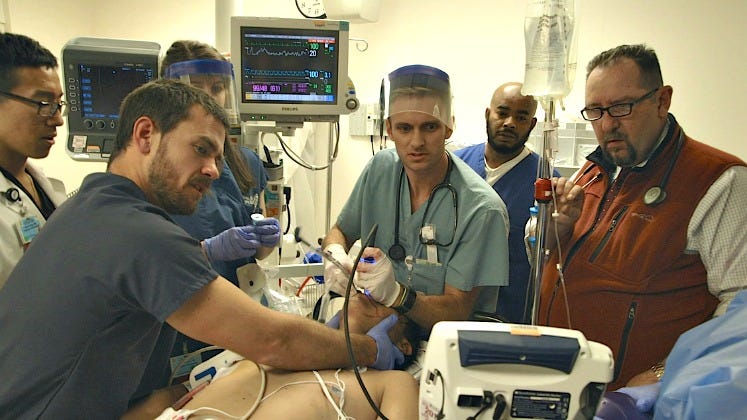Code Black

Ryan McGarry’s arresting documentary “Code Black” is like a microcosm of our broken healthcare system: too much focus on money and paperwork, not enough time and resources devoted to curing people in need. Rather than the shouting we’re used to when we talk about healthcare these days, McGarry opts for a journalistic look that captures the frustration while remaining avowedly apolitical.
It follows a group of young medical students in 2008 and picks up their story again four years later when they’re senior emergency room docs. They all work in the Los Angeles County Hospital, where the indigent and uninsured come for help in droves.
The title refers to the frequent occasions in which the waiting room is filled to bursting with people, many of them with injuries or illnesses that would immediately see them wheeled in to see a doctor at most other hospitals. Wait times of 12 to 18 hours are not unusual.
Through it all, these doctors — many of them on the young side of 30 — struggle to provide quality care while dealing with a lack of nurses or a crush of bureaucracy that puts patients last. This film will break your heart but leave you with some semblance of hope if devoted people like this represent the vanguard of the future.
In the early section, L.A. County Hospital is an ancient structure ill-equipped by modern medical standards. The heart of the ER is “C-Booth,” where a swarm of doctors and support staff surround the patients thrashing away on a gurney. Beds are stacked right next to each other, and blood often covers the floors. Privacy is a foreign concept.
And yet the doctors are bonded in an espirit de corps, feeling like warriors in a “hurt locker” devoted to staving off death, not inflicting it. As one graybeard administrator explains, because a modern focus on filling out forms and following procedures wouldn’t work in this antiquated facility, they’re given waivers to boot most of the bureaucracy.
The result is a nasty chaos but one where the focus is on the patients.
By 2012, the ER now occupies an antiseptic wing of the new hospital building. Docs spend huge chunks of their time hunched at computer workstations. Some spend 30 minutes filling out (computerized) paperwork for a patient they spent two minutes treating. Meanwhile, the sick and injured are stacked 300 deep in the waiting area.
One doctor launches an initiative to clear out the clutter. He calls it Frontline, and it’s basically a triage/treatment center for the worst cases. They come in the door and go straight to a doctor for assessment in a special area. Astonishingly, average wait times drop by 50 percent.
But there’s pushback from nurses concerned about losing their licenses to practice by not following state and federal rules. An administrator needs nurses to staff other departments that have been cut back. Frontline falls silent and dark, and Code Black is again the order of the day.
This stark portrait of how the sausage is really made at emergency rooms in Los Angeles (and everywhere) will vex and confound. Sometimes, brutal honesty is the best medicine.
4.5 Yaps

